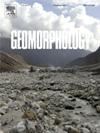Unravelling litho-structural and tectonic influences on geomorphic and river longitudinal profile character in the Brahmani River Basin of eastern India
IF 3.1
2区 地球科学
Q2 GEOGRAPHY, PHYSICAL
引用次数: 0
Abstract
The Brahmani River basin in eastern India exhibits marked influence of tectonic and litho-structural control in its incised stream reaches, sharp changes in channel direction and the presence of numerous structural discontinuities. The combined effect of these attributes in shaping the basin geomorphology and landscape character are analysed through detailed morphometric evaluation at the sub-watershed level, overlaying lithological and geomorphic units on relevant terrain parameters extracted from Copernicus-DEM tiles and ancillary map information. Alongside this, we also analyse the longitudinal profile character of the principal stream and its main tributaries to discern knickpoints and their locations in terms of rock types and their possible origins, discerning that these are mostly situated in granitic and quartzite terrain and at elevations above 300 m. Higher values of stream gradient (SL) index indicate regional uplift, and possibly tectonically affected areas, often near vertical knickpoints along fault zones in varying litho-structural units. Computed Chi (χ) plots suggest zones of river capture and drainage divide migration, with χ values decreasing from north to south across the basin and sub-watershed divides shifting towards northwest for the Lawa river, north-eastwards for the Sankh, South Koel and North Karo rivers, and towards southeast for the South Karo river. The probable paleo-surfaces and paleo-profiles of these streams is also reconstructed, based on their present longitudinal elevation and overall uplift extents from m.s.l. are estimated (~540 m uplift and ~45 m uplift in the upper and lower basin zones, respectively). Our analysis makes it evident that most channel segments are not in an equilibrium phase, thus denoting the continued influence of structural and possible latter-day tectonic movements (as evidenced by recent local seismic activity), through reactivation of the crustal-scale basement faults, shear zones and mobile belts that lie astride and across the Brahmani Basin in the Eastern Ghats hills.
求助全文
约1分钟内获得全文
求助全文
来源期刊

Geomorphology
地学-地球科学综合
CiteScore
8.00
自引率
10.30%
发文量
309
审稿时长
3.4 months
期刊介绍:
Our journal''s scope includes geomorphic themes of: tectonics and regional structure; glacial processes and landforms; fluvial sequences, Quaternary environmental change and dating; fluvial processes and landforms; mass movement, slopes and periglacial processes; hillslopes and soil erosion; weathering, karst and soils; aeolian processes and landforms, coastal dunes and arid environments; coastal and marine processes, estuaries and lakes; modelling, theoretical and quantitative geomorphology; DEM, GIS and remote sensing methods and applications; hazards, applied and planetary geomorphology; and volcanics.
 求助内容:
求助内容: 应助结果提醒方式:
应助结果提醒方式:


